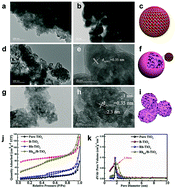Band engineering of mesoporous TiO2 with tunable defects for visible-light hydrogen generation†
Abstract
A limited light absorption range and low electron transfer efficiency have always been the major problems in semiconductor photocatalysis. Here, a defect-rich heterophase junction-containing TiO2 porous nanostructure was designed and synthesized to improve the low utilization rate of photoexcited carriers in photocatalysis. Defects were first introduced into titanium dioxide, and co-doping was used to obtain defect-rich materials. At the same time, heterophase junction TiO2 with anatase and rutile phases was obtained under temperature control. The TiO2 phase junction could significantly improve the interface charge recombination. These two synergistically regulated the hydrogen production favorably, thus improving the carrier separation efficiency and reducing the band gap from the ultraviolet to the visible region, which resulted in the construction of the most effective defects. Theoretical predictions and empirical characterizations indicate that TiO2 with defects introduced into it presents a porous structure, and the doped phase exposes the internal defects of the bulk phase of the material to the surface and adjusts the defect position. The experimental results confirmed that the synergistic effect of B and Rh co-doping increased the photocatalytic hydrogen production yield of TiO2 by 10 times. This study provides new insights into photocatalyst defect regulation.



 Please wait while we load your content...
Please wait while we load your content...